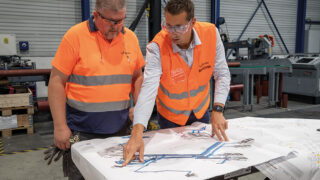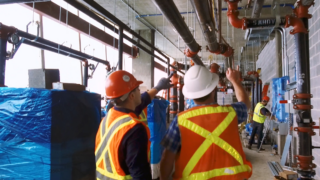View this blog in another language:
Danish Finnish French German Norwegian Swedish
Posted on May 8th, 2024
A shift from the traditional linear model of “take-make-waste” to a circular, whole-life cycle approach of “reduce-reuse-recycle” is essential to cut construction waste and to reduce the amount of waste to goes to landfills. That means not only considering the environmental impact of the materials you chose and use, but also the potential for maintainability, recovery and reuse or recycling of those materials when their current job is finished.

In the final installment of our Circularity in Construction series, we will have a more in-depth look at system maintainability, adaptability and demolition and consideration for end-of-life scenarios.
We are in it for the long haul
Imagine the waste reduction with system components that never need to be replaced. That is exactly what grooved piping solutions provide. Once they are installed, they will last for the life of the system.
Once installed, grooved mechanical couplings do not require maintenance. The gasket’s C-shaped cross section seal is durable and can handle significant compressive and cyclical loading: workers can pressurize and depressurize a system repeatedly for many years without fatiguing the rubber. In a welded flanged system, however, the torque on the bolts employs a high compressive load on the internal gasket, which makes it stick to one or both flanges. When flanges are disassembled, all of the bolts and nuts must be removed and oftentimes the gasket will tear, causing it to fail upon reinstallation.
Additionally, a grooved mechanical pipe-joining system accommodates vibration without the need for periodic product repair or replacement. Welded or flanged piping systems utilize rubber bellows or braided flexible hoses to accommodate vibration, but these specialty items are prone to wearing out over time, resulting in additional waste. Flexible grooved mechanical systems allow the pipe to move and vibrate within the coupling, localizing vibrations generated by equipment and reducing the amount of noise transmitted down the pipeline, all without wearing out the gasket.
Maintenance is simpler and cleaner
With a reliable union at every joint, grooved mechanical systems allow for quick and easy access for routine system maintenance, system expansion or pipeline repair.To access the system via a grooved mechanical coupling, a worker simply unscrews two nuts and drops the section out without the need for a torch, saw or welding machine. Required maintenance, such as replacing strainers or corrupt pipe sections or slipping in a tee to expand or join piping systems, is easily accomplished. To complete the job the gasket is reinstalled, the coupling is placed back on the pipe or fitting, and the two bolts are tightened. Welded systems, in contrast, require workers to fully drain the system, cut out the damaged pipe section and weld a new section in, which causes emissions, additional waste, operational concerns and safety hazards, particularly in existing facilities and occupied spaces.
Reclassification of building use class
Grooved pipe joining makes piping systems infinitely reconfigurable, significantly reducing pipe waste far into the future. Aside from routine maintenance, it is sometimes necessary to join two existing systems within a structure. In space planning and refurbishment projects, the grooved system is easily re-routed due to a union at every joint. Operating efficiency can be maintained during retrofit work, and systems can remain live because properly placed butterfly valves provide “dead-end” shutoff service for isolation. Additionally, owners can engage in retrofit projects in occupied buildings without having to vacate the space because grooved mechanical piping re-work does not negatively affect indoor air quality or introduce a fire hazard.
End-of-life scenarios
According to the UN’s Global Alliance for Buildings and Construction, more than a third of construction, renovation and demolition waste generated every year goes into landfills. Circular products help to reduce the amount of waste since they are more reliable and long-lasting. When the time finally comes that a building reaches the end of its life, grooved pipes can easily be disassembled, cleaned, and reused or repurposed, reducing single-use materials. What’s more, Victaulic products are largely recyclable back into their original state, furthering their value. Coupling housings, fittings and valve bodies get melted again in our facilities with zero waste, as do bolts and nuts. Gaskets get a second life in projects like playground surfaces, athletic tracks and cushioning for artificial turf.

Putting the construction sector on a circular economy trajectory is crucial for reducing waste and for achieving national climate targets. We are all responsible for reducing our business’s environmental impact, and it will require all industry stakeholders working together with a circular mindset to make sustainable progress in construction.
Visit our sustainability page to download our Sustainability Report and learn more about our sustainable construction solutions. Ready to take the next step? Connect with our experts to see how we can implement circularity in your upcoming projects.



